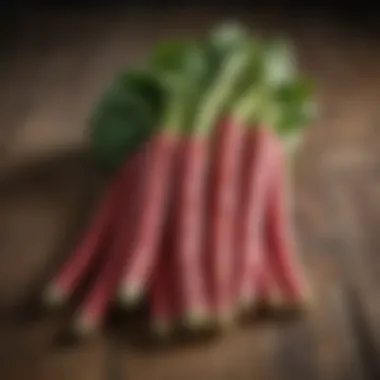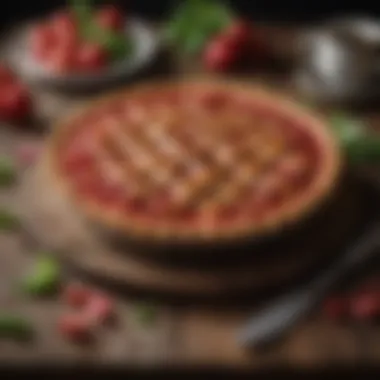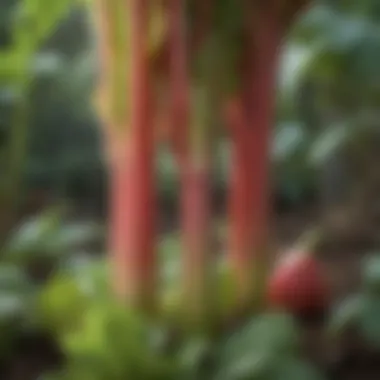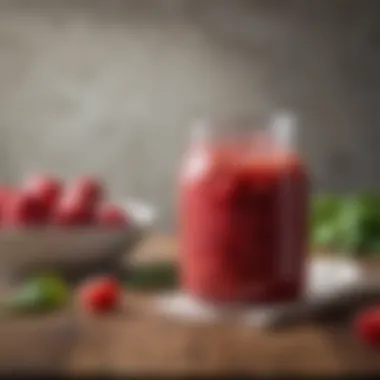Exploring Rhubarb: Availability, Uses, and Benefits


Intro
Rhubarb is a unique vegetable that often behaves like a fruit in culinary practices. Understanding rhubarb’s availability and uses enriches both cooking and awareness of its health benefits. Rhubarb has a complex history; it has evolved from traditional medicinal use to modern culinary applications that showcase its tartness.
This article aims to guide you through the world of rhubarb, examining when it is in season, where to purchase it, and how to use it effectively in the kitchen. Additionally, it covers some of the nutritional aspects of rhubarb, establishing why incorporating it into your diet can be advantageous.
Recipe Overview
Rhubarb Crisp
Description of the Dish
Rhubarb Crisp is a delightful dessert that features the tangy flavor of rhubarb, combined with sweet elements of sugar and a crunchy oat topping. The balance between sweet and tart creates a harmonious dish that can be served warm or cold. It is a simple yet elegant way to enjoy rhubarb, making it a favorite during its peak season.
Ingredients
- 4 cups rhubarb, chopped
- 1 cup granulated sugar
- 1 cup old-fashioned oats
- 1 cup all-purpose flour
- 1/2 cup brown sugar
- 1/2 cup unsalted butter, softened
- 1 teaspoon cinnamon
- 1/4 teaspoon salt
Special Notes on Ingredients
- Rhubarb: Opt for fresh rhubarb if possible, as it provides the best flavor. Frozen rhubarb can also be used; just thaw it properly.
- Sugar: Adjust sugar levels according to personal taste and the tartness of the rhubarb. Substitute with honey or a sugar alternative for a different flavor profile.
- Butter: For a dairy-free option, consider using coconut oil or a plant-based butter substitute.
Rhubarb is not just a seasonal crop; it symbolizes spring in many cultures with its vibrant red stalks.
This recipe showcases not only rhubarb's versatility but also introduces a classic preparation method that enhances its natural flavor. Be sure to try Rhubarb Crisp during the peak season to fully appreciate its freshness.
Preface to Rhubarb
Rhubarb is a fascinating plant that deserves a place in the culinary world. This introduction gives readers insight into its unique characteristics, importance, and uses. Understanding rhubarb provides a solid foundation for appreciating not just its flavor but also its historical context and nutritional value. One will find that rhubarb is more than just a garden variety; it has a storied past and extensive culinary applications.
Defining Rhubarb
Rhubarb is a perennial vegetable, which is often mistakenly considered a fruit. The part we eat is the stalk, which is characterized by its tart taste and crunchy texture. The leaves of the plant, however, are toxic and should never be consumed. Rhubarb stalks come in various colors, predominantly green and red. The intensity of the color can indicate the level of maturity and sweetness.
When purchased fresh, rhubarb should be firm and crisp, which indicates quality. The broader understanding of rhubarb transcends its physical attributes; its versatility in cooking is noteworthy. It serves not only in sweet desserts, such as pies, but also as a companion in savory dishes. Thus, it fits well into varied cuisines.
Historical Significance
Rhubarb has a long history that's as captivating as its taste. Originating from Asia, its use dates back thousands of years primarily for medicinal purposes. Ancient Chinese civilizations valued rhubarb for its health benefits, using it in traditional medicine. It made its way through trade to Europe by the 14th century where it was cultivated as well, yielding both culinary and medicinal uses.
Over the centuries, especially in Europe and North America, rhubarb evolved into a staple in home cooking. The iconic rhubarb pie emerged from this tradition, becoming a symbol of North American comfort food. In fact, in the United States, rhubarb is so cherished it is often dubbed "the pie plant."
Rhubarb's role in cuisines has shifted through eras, reflecting broader trends in food culture. As contemporary cooks rediscover traditional ingredients, rhubarb is experiencing renewed interest, reinforcing its place in modern kitchens.
"Rhubarb bridges the gap between sweet and tart, making it a unique ingredient in kitchens around the world. "
Can Buy Rhubarb Now?
Determining the availability of rhubarb is crucial for those keen on incorporating this unique vegetable into their culinary repertoire. Understanding when rhubarb is in season aids consumers in finding the freshest produce. Seasonal knowledge also informs one’s purchasing decisions, ultimately enhancing the overall eating experience. Knowing the timeframe for rhubarb availability can significantly impact recipe planning and preparation.
Seasonality of Rhubarb


Rhubarb typically has a specific growing season, influenced by climate and region. In general, rhubarb is most readily available from late spring to early summer, specifically from April to June in many parts of North America. This growth cycle is primarily due to its preference for cooler temperatures, making it a uniquely seasonal vegetable. In some areas, rhubarb may be harvested earlier or later, depending on local weather conditions. Cultivators also grow certain varieties that can extend this season a bit. Thus, consumers should be mindful of their geographical location when seeking out fresh rhubarb.
During the off-season months, rhubarb may become harder to find or will only be available in canned or preserved forms. These alternatives can vary in flavor and texture from fresh rhubarb, which is why understanding the season is essential.
Locating Fresh Rhubarb
Finding fresh rhubarb requires a diligent approach. Local farmers’ markets are an excellent starting point. Typically, these markets feature seasonal produce sourced directly from nearby farms. Many vendors prioritize freshness, so their rhubarb may be of superior quality compared to items in large grocery chains.
In addition to farmers' markets, grocery stores are another potential source. Supermarkets like Whole Foods and Trader Joe's often stock fresh rhubarb during its peak season. It is advisable to check the produce aisle regularly, especially in spring.
For those unable to find rhubarb locally, online options are increasingly popular. Websites like Amazon and specialty produce retailers allow you to order fresh rhubarb directly to your door. However, ensuring the produce is fresh and of high quality should be a priority when opting for online purchases. Delivery times and conditions can affect the produce quality.
"Fresh rhubarb is not just a culinary delight; it is also seasonally prized, offering flavors that change dramatically based on its growing conditions."
Overall, knowing when and where to buy rhubarb can greatly enhance its use in the kitchen. As with all ingredients, the fresher the produce, the better the outcome in your culinary endeavors.
Where to Purchase Rhubarb
Understanding where to purchase rhubarb is essential for anyone looking to incorporate this unique vegetable into their diet. It can be a challenge to find good quality rhubarb, especially if one does not know the best sources. Knowing where to buy rhubarb ensures that you select fresh produce, which can make a significant difference in taste and health benefits. The availability of rhubarb also varies by region and season, making it crucial to be informed about the best purchasing options available. In this section, we will explore three primary sources for obtaining rhubarb: local farmers' markets, grocery store varieties, and online purchasing options.
Local Farmers' Markets
Local farmers' markets are often the ideal place to find fresh rhubarb. These markets usually offer seasonal vegetables and products sourced directly from farmers. The advantage of buying from these markets is the opportunity to select rhubarb that is freshly harvested. Additionally, you can ask the farmers directly about the growing practices used, which allows for a more informed purchase.
- Freshness: Farmers typically sell their products soon after harvest, ensuring maximum freshness.
- Quality: You can visually inspect the rhubarb for quality. Look for firm stalks with vibrant colors.
- Support Local Economy: Purchasing from local markets helps support community farmers and their sustainable practices.
Grocery Store Varieties
Grocery stores provide a convenient option for purchasing rhubarb, especially for those who may not have access to a farmers' market. Major grocery chains often stock rhubarb during its peak season. When purchasing from grocery stores, consider the following aspects:
- Availability: Depending on the supermarket and time of year, you may find rhubarb readily available in the produce section.
- Varieties: Some stores may offer different types of rhubarb, including standard pie rhubarb and ornamental rhubarb varieties. Be sure to choose those meant for culinary use.
- Packaged Options: Grocery stores sometimes offer pre-cut or packaged rhubarb for added convenience. However, it’s important to ensure that this product meets your quality expectations.
Online Purchasing Options
In today's digital age, online shopping offers a unique way to purchase rhubarb. This method can be advantageous for those living in areas where local options are limited. Various online retailers specialize in fresh produce or specialty foods that include rhubarb. Some considerations include:
- Convenience: Buying online allows you to browse a range of products and place orders from the comfort of your home.
- Research Vendors: Ensure that you select reputable vendors with good reviews to guarantee the quality of the rhubarb.
- Shipping: Check if the vendor provides shipping options that maintain the freshness of the produce during transit.
Overall, knowing where to purchase rhubarb is vital for obtaining high-quality produce, ensuring that you can enjoy its tart flavor and health benefits in your dishes.
Selecting Fresh Rhubarb
Selecting fresh rhubarb is a critical aspect of incorporating this unique vegetable into your culinary endeavors. As rhubarb is prized for its tart flavor and versatility, understanding how to choose quality stalks can greatly enhance your cooking experience. Freshness significantly affects both taste and texture, so knowing the key indicators of quality rhubarb is essential.
Identifying Quality Rhubarb
When it comes to identifying quality rhubarb, there are several important factors to consider. First, look for vibrant color; fresh rhubarb typically displays a range of hues, from deep red to lighter green. The color may vary, but vibrant stalks generally indicate freshness.
Moreover, inspect the stalks themselves. They should be firm and crisp, without any signs of wilting or browning. A stalk that bends too easily might be overripe. It is also crucial to check for blemishes or soft spots, as these are signs of decay. Avoid any stalks with these imperfections.
In addition to visual checks, consider the smell. Fresh rhubarb has a pleasant, earthy aroma, whereas the scent of spoiled rhubarb may be sour or off-putting. Ensure that you handle rhubarb carefully. Delicate stalks can easily bruise, which affects quality.


Fresh rhubarb should be vibrant in color, firm to touch, and free from blemishes. This ensures the best flavor in your dishes.
Storage Tips
Knowing how to store fresh rhubarb is just as vital as selecting it. Proper storage will help maintain its quality for a prolonged period. Store rhubarb in the refrigerator, ideally within the crisper drawer, where humidity is regulated. Wrapping the stalks in a damp paper towel can help retain moisture and prevent them from drying out.
When storing rhubarb, avoid washing it until you are ready to use it. Excess moisture can lead to mold growth. Fresh rhubarb typically stays good in the refrigerator for about one to two weeks. However, if you notice any signs of spoilage, dispose of it immediately to avoid affecting other produce.
If you have an abundance of rhubarb and cannot use it all within this timeframe, consider freezing it. Cut the stalks into manageable pieces, wash them thoroughly, and then freeze them in an airtight container. This allows for longer storage without significant loss of quality, making it possible to enjoy rhubarb beyond its seasonal availability.
Culinary Uses of Rhubarb
Rhubarb is often underappreciated in the culinary world, yet it offers a unique flavor that can enhance numerous dishes. Its tart profile and striking color make it an excellent addition to both sweet and savory recipes. Understanding the culinary uses of rhubarb is essential for home cooks and professional chefs alike. The versatility of this vegetable can lead to exciting explorations in the kitchen, allowing one to create anything from desserts to sauces.
One of the key elements of utilizing rhubarb in cooking is its ability to balance flavors. The natural tartness can counterbalance sweetness, making it a perfect candidate for various desserts.
In addition to its flavor, rhubarb provides nutritional benefits that can elevate a meal. Not only is it low in calories, but it contains essential vitamins and minerals such as vitamin K, vitamin C, and calcium. Incorporating rhubarb into your dishes adds both flavor and healthful nutrients.
Common Recipes Featuring Rhubarb
Rhubarb shines in several recipes that capitalize on its tart characteristics and vibrant color. Here are some notable examples:
- Rhubarb Pie: A classic dessert that highlights the vegetable's sour taste against a sweet, flaky crust. It pairs well with vanilla ice cream.
- Rhubarb Crisp: This dish combines the tartness of rhubarb with a crunchy oatmeal topping, offering a satisfying texture contrast.
- Rhubarb Compote: A simple yet flavorful sauce made by cooking rhubarb with sugar and lemon juice. It can be served over pancakes or yogurt.
- Rhubarb Jam: Preserving rhubarb into a jam captures its unique flavor, allowing it to be spread on toast or incorporated into desserts throughout the year.
These recipes show that rhubarb is not limited to a single culinary application; instead, it can occupy a variety of roles in meal preparation.
Pairing with Other Ingredients
When cooking with rhubarb, the choice of complementary ingredients is vital in developing a well-balanced dish. Here are some effective ingredients to pair with rhubarb:
- Strawberries: The sweetness of strawberries works harmoniously with rhubarb's tartness.
- Ginger: Adding ginger can introduce warmth and spice, balancing the sharp flavor of rhubarb.
- Apples: When included in crumbles or pies, apples add natural sweetness to offset rhubarb's acidity.
- Citrus Fruits: Lemons and oranges can enhance the flavor profile, adding freshness and brightness to rhubarb dishes.
By understanding what pairs well with rhubarb, cooks can unleash its full potential, creating memorable meals that delight the palate.
Ultimately, the culinary uses of rhubarb are as diverse as they are enjoyable. Whether utilizing its tartness in sweets or its depth in savory dishes, rhubarb deserves a prominent place in culinary exploration. It encourages creativity and experimentation in the kitchen, opening doors for numerous recipe possibilities.
Nutritional Benefits of Rhubarb
Rhubarb is not just a culinary ingredient; it also brings notable nutritional benefits that can enhance overall health. In this section, we will explore the key vitamins, minerals, and health advantages that this unique vegetable possesses. Understanding these aspects is essential for anyone looking to incorporate rhubarb into their diet effectively. The array of nutrients in rhubarb can contribute to various health considerations, making it a valuable addition to meals.
Vitamins and Minerals
Rhubarb contains a variety of vitamins and minerals that are important for maintaining good health. Some of the key nutrients include:
- Vitamin K: Essential for blood clotting and bone health, rhubarb is a good source of Vitamin K. Just one cup can provide significant amounts of this important vitamin.
- Vitamin C: This vitamin acts as an antioxidant, supporting immune function and skin health. Including rhubarb in your diet can help boost your daily Vitamin C intake.
- Potassium: Necessary for heart health, potassium helps manage blood pressure and supports proper muscle function. Rhubarb contributes to your potassium needs with each serving.
- Calcium: This mineral is vital for maintaining strong bones and teeth. The presence of calcium in rhubarb adds to its appeal as a nutritious vegetable.
Along with these, rhubarb also has small amounts of other essential vitamins and minerals, including iron and magnesium.
Health Benefits


The health benefits of rhubarb extend beyond its vitamin and mineral content. Some notable advantages include:
- Digestive Health: Rhubarb has a high fiber content, which promotes healthy digestion. Fiber helps to keep the digestive system functioning properly and can aid in preventing constipation.
- Weight Management: Low in calories and high in fiber, rhubarb can be beneficial for those looking to maintain or lose weight. It can provide bulk to meals, aiding in satiety without adding excessive calories.
- Antioxidant Properties: The presence of antioxidants in rhubarb, particularly anthocyanins, can combat oxidative stress in the body. This may reduce the risk of chronic disease and promote overall well-being.
- Bone Health: The combination of Vitamin K and calcium supports bone strength. Regular consumption of rhubarb can contribute to maintaining bone density, reducing the risk of fractures.
Incorporating rhubarb into your meals not only adds unique flavors but also provides essential nutrients that support health in various ways.
Preserving Rhubarb
Preserving rhubarb is an essential aspect of its culinary journey. This technique allows food lovers to enjoy this unique vegetable beyond its growing season. By understanding methods of preservation, you can extend the life of rhubarb and explore its diverse uses throughout the year. This section will discuss two primary methods: freezing and making preserves, each offering distinct advantages and opportunities for culinary exploration.
Freezing for Future Use
One effective way to preserve rhubarb is by freezing it. Freezing maintains the vegetable's flavor, nutritional value, and texture, making it a popular choice among home cooks. The first step in this process is the selection of fresh, high-quality rhubarb stalks. Choose those with a rich color and firm texture, as these are indicative of freshness.
- Preparation: Clean the rhubarb under cool water to remove any dirt. Trim the ends and slice the stalks into pieces, typically one to two inches long.
- Blanching: To preserve flavor and color, blanch the rhubarb in boiling water for 1-2 minutes. This step is not mandatory but can enhance quality. After blanching, quickly transfer the stalks to an ice bath to halt cooking.
- Packaging: Once cooled, drain the rhubarb and pat it dry. Place the rhubarb pieces in airtight freezer bags. Remove as much air as possible before sealing. Label with the date for future reference.
- Storage: Store the frozen rhubarb in the freezer. It can last up to a year while retaining its taste and quality. When needed, simply take out the required amount for cooking or baking.
Freezing offers convenience and ensures that you have rhubarb available for pies, jams, and other dishes year-round.
Making Rhubarb Preserves
Making rhubarb preserves is another delightful way to extend the enjoyment of this vegetable. Preserves not only enhance the shelf life of rhubarb but also transform it into a sweet treat that can complement various foods.
To create rhubarb preserves, follow these steps:
- Ingredients: Gather the following ingredients: fresh rhubarb, sugar, lemon juice, and water. The sugar acts as a preserving agent, while lemon juice aids in balancing the flavors.
- Cooking: In a pot, combine chopped rhubarb, sugar, and a splash of water. Cook over medium heat, stirring occasionally, until the rhubarb breaks down and a thick syrup forms, usually around 15-20 minutes.
- Bottling: Once the desired consistency is achieved, pour the preserves into sterilized jars while hot. Seal the jars with lids and allow them to cool. This cooling process creates a vacuum seal, contributing to longer shelf life.
- Storage: Store the sealed jars in a cool, dark place. When opened, rhubarb preserves can last in the refrigerator for several weeks. They are perfect for spreading on toast, topping desserts, or adding a unique twist to savory dishes.
Making preserves not only provides delicious options for future use but also allows for creativity in the kitchen. Experiment with different spices and fruit combinations to find your signature blend.
"The art of preservation keeps the essence of rhubarb alive, enriching our culinary landscapes regardless of season."
Preserving rhubarb means unlocking endless possibilities for enjoyment. Whether through freezing or making preserves, these methods ensure that this versatile vegetable can be savored and appreciated far beyond its typical harvest season.
Culmination and Final Thoughts
As we wrap up this exploration of rhubarb, it’s clear that this unique vegetable holds a multifaceted place in contemporary cuisine. Understanding its availability, culinary uses, and nutritional aspects enhances the appreciation for rhubarb in the kitchen and on our plates. The seasonal nature of rhubarb means that its presence in grocery stores and markets can be limited, making awareness crucial for those seeking the freshest produce.
Emphasizing the importance of selecting quality rhubarb can elevate any dish, whether it's a classic pie or a modern salad. Each step—from buying to preserving—matters greatly in retaining its tartness and vibrant color. Additionally, the historical context enriches our understanding of its journey, showing how rhubarb has evolved from a medicinal plant to a beloved ingredient in desserts and savory dishes.
"Understanding rhubarb allows for a deep appreciation of its versatility and nutritional value."
In concluding, we see that rhubarb isn’t just food. It’s an opportunity for creativity in the kitchen. Recognizing the benefits, seasonal availability, and practical culinary applications encourages experimentation with this versatile vegetable.
Summarizing the Journey with Rhubarb
Throughout this article, we journeyed from the basics of defining rhubarb to exploring its historical significance. We delved into its seasonality and purchasing locations, allowing readers to know when and where to find fresh rhubarb. The culinary applications were especially fascinating, showcasing recipes that utilize this unique flavor and pairs with complementary ingredients. Reading about the rich vitamins and minerals present in rhubarb opened discussions on health benefits, revealing its role beyond just taste.
Moreover, the methods for preserving rhubarb provide practical insights for maximizing enjoyability year-round. Whether fresh or preserved, knowing how to store, freeze, or make preserves from rhubarb adds lengths of flexibility in cooking.
Encouraging Culinary Exploration
Now that we have navigated through the intricate details of rhubarb, it’s time to encourage culinary exploration. This vegetable's versatility isn't limited to mere pies. Home cooks should consider integrating rhubarb into a variety of dishes. From tangy sauces and chutneys to refreshing salads, the possibilities are numerous.
Here are some ideas to spark creativity:
- Rhubarb Compote: A simple dish that can be enjoyed over yogurt or pancakes.
- Rhubarb Smoothies: Combine with fruits like strawberries for a nutritious drink.
- Savory Dishes: Use rhubarb in savory stews or pair with meats for a unique flavor profile.
Moreover, this exploration should empower individuals to experiment with recipes that combine rhubarb with other seasonal ingredients. Knowing how to properly prepare rhubarb will take any dish to dizzying new heights. Let your curiosity lead you to discover what rhubarb can bring to your table.







